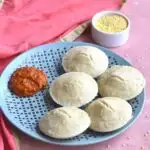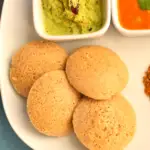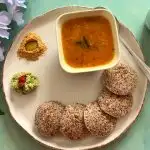Soft, fluffy, and piping hot, idli has a way of bringing people together at the breakfast table. This classic South Indian dish isn’t just a local favorite—it shows up on menus and home kitchens all over India. Kids, parents, and even grandparents enjoy it, sometimes as a quick morning bite and sometimes as a comfort food on a slow weekend.

Idli’s mild flavor, paired with spicy chutneys or sambar, offers something for almost every taste. Its simple ingredients and gentle cooking method make it easy on the stomach. Whether you grew up eating it or you’re trying it for the first time, idli has a charm that keeps generations coming back for more.
Idli and Memories
Being a North Indian I am an Idli Fan and so is my family. However, today I am writing this post for Father’s day and dedicating this post to my dad who loves Piping hot Idli. Yes the moment the idli is removed it needs to be served to him. He likes it that way. Dunked in his favourite Coconut chutney with Sambar on his side he will enjoy this whole heartedly.
Growing up, Idli, Dosa was a weekend affair once in a month for us. My mom used to make a big batch for us and we used to eat it for breakfast, lunch and if anything remains even for dinner. All the varieties being made and by everyone in the house. So many memories.
I am sharing this with our group Sunday Funday where the theme for this Sunday is to make your or your kid’s dad’s favourite recipe. I chose my dad 😀. The theme is hosted by Camilla M. Mann.
What is Idli?
Idli is a soft, white, and slightly tangy rice cake that’s served fresh and warm across South India. You’ll find it stacked on bright banana leaves in cafés and packed lunch boxes, often accompanied by flavorful side dishes. At first glance, idli seems simple, but each bite tells you why it’s such a breakfast staple—light, mild, and filling without being heavy.
Core Ingredients
Idli begins with just a handful of everyday ingredients, yet the result tastes unique and comforting.
- Rice: Usually a variety like parboiled rice, which brings the right texture.
- Urad Dal (Split Black Gram Lentils): These small, creamy lentils help idli turn soft and fluffy.
- Water: For soaking and blending.
- Salt: To bring out the subtle flavors during fermentation.
No fancy extras, no mystery additions. It’s all about quality and freshness. The ingredients typically soak in water before being ground into a smooth batter, then left to ferment overnight. This step is key—it creates tiny air pockets inside each idli, making them so light and spongy.

What Makes Idli Distinctive
Several details set idlis apart from other breakfast foods in India and beyond:
- Fluffiness: Thanks to fermentation, idlis puff up during steaming. They feel soft, almost cloud-like, under your fork or fingers.
- Mild, Tangy Flavor: The fermentation gives a gentle tang, balancing the rice and dal’s neutral taste.
- Steamed, Not Fried or Baked: Idli’s pillowy texture comes from steaming, which uses no oil. This makes them lighter on the stomach and suitable for most diets.
- Easy to Eat: No crust, edges, or tough bits. Idli breaks apart easily, perfect for kids and adults alike.
This soft texture and clean taste give idli a universal appeal. It’s meant to be enjoyed fresh, often sopping up spicy chutney or a bowl of sambar. The best idlis almost bounce back when pressed.
How Idli is Made
Ingredients Used in Idli Batter
Idli starts with just a few items you can find in almost any Indian kitchen. You won’t see long lists or hard-to-find spices.
- Rice: Parboiled rice is a classic choice—it cooks evenly and keeps idlis soft.
- Urad dal: This split black gram acts like glue and air pump, providing both shape and fluffiness.
- Water: Needed for soaking and grinding, and to adjust the batter’s thickness.
- Salt: Brings out the light tang and keeps the batter from tasting flat.
- (Optional: A pinch of fenugreek seeds, sometimes added for extra fermentation and softness.)
Here’s the flow:
- Measure rice and urad dal, usually in a 3:1 ratio.
- Rinse and soak them, each in their own bowl, for 6 hours or overnight.
- If you want, toss in a teaspoon of fenugreek seeds to soak with the dal.
Keep it simple. There’s no need for baking powder, yeast, or shortcuts.
Importance of Fermentation
Fermentation is where magic happens. This step gives you that slightly tangy, airy idli and is totally natural—no commercial yeast needed.
After soaking, you blend the rice and dal separately until smooth. Add water as you go to get a thick but pourable batter, then combine both in one bowl. Stir in salt, cover loosely, and leave it somewhere warm to rest.
What’s happening here?
- Naturally present bacteria and wild yeast start to work as the batter sits.
- They break down starches, puffing up the mix with tiny bubbles.
- This process takes 8 to 12 hours, sometimes longer if it’s cold, shorter in summer.
- I have a very detailed post on Fermenting Batter in Cold Climate. Read this for all the tips and tricks.
You’ll know the batter is ready when:
- It’s grown in size, almost doubled.
- The top looks a bit bubbly.
- It smells faintly sour, almost like mild yogurt.
A good fermentation turns heavy rice and dal into a soft, easy-to-digest mix
Steaming: Getting Idlis Fluffy and Soft
Steaming turns the bubbly batter into idlis that feel light as clouds. No oil, frying, or baking—just gentle, moist heat.
Here’s how it goes:
- Grease the idli molds lightly with oil, just enough so the cakes pop out.
- Fill each mold about three-quarters full with fermented batter.
- Stack the trays in a steamer, making sure there’s room for steam to flow.
- Steam for 10 to 15 minutes—don’t peek early or you’ll let the heat escape.
When they’re done, a toothpick poked in the center should come out clean. Slide the idlis out gently with a spoon or knife.
That steam gives idlis their signature bounce. It cooks without drying or crisping, and keeps things soft all the way through. This gentle method is why idlis are easy for everyone, even toddlers and the elderly, to enjoy.
With a little practice, the steps become second nature. Each fresh batch pulls you back to breakfast tables across South India, where soft idlis mean a brand-new day.
Classic Varieties: Plain, Rice, and Rava Idli
Everyone knows the soft, snow-white idli made from rice and urad dal, but even the classics offer plenty of variety. Here are a few idli recipes you will find on my blog.




Serving and Enjoying Idlis
Classic Sides: Chutney and Sambar
If you’ve ever sat down for a South Indian breakfast, you know that idli almost never arrives alone. The experience isn’t complete without a scoop (or two) of chutney and a ladle of piping hot sambar.
Popular Chutneys:
- Coconut Chutney: This mild, creamy dip uses grated coconut, green chilies, and a tempering of mustard seeds. It’s a go-to for its cool, fresh taste.
- Tomato Chutney: Sweet-tart tomatoes mixed with onions, red chilies, and garlic. Adds a tangy kick.
- Mint or Coriander Chutney: Packed with herbs, these chutneys bring a bright, zesty flavor that complements the soft idli.
- Peanut or Roasted Chana Chutney: Nutty, rich, and savory, these provide a heartier dipping sauce.
Sambar:
Sambar is a spiced lentil stew loaded with vegetables like carrots, drumsticks, and pumpkin. Its comforting flavors come from toor dal (split pigeon peas), tamarind, and sambar masala. The best way to serve? Soak your idli in a bowl of steaming sambar and watch it soak up all that tangy, spicy goodness.
Serving Tips:
- Serve idlis warm in a steamer or lined basket to keep them fluffy.
- Arrange chutneys in small bowls for easy dipping or drizzling.
- Offer a bowl of hot sambar on the side or pour it over the idlis for instant comfort.
- For a homestyle touch, drizzle ghee over hot idlis before serving.
A plate with at least two chutneys and a helping of sambar will please everyone at the table.
Recipe Card

Soft Idli
Equipment
- Steamer Vessel
Ingredients
- 1 Cup Urad Dal
- 3 Cup Rice Par Boiled rice preferred
- 1 teaspoon Fenugreek Seeds Optional
- Salt as required
- Oil for greasing
- Water for steaming
Instructions
Making Idli Batter
- Measure rice and urad dal, usually in a 3:1 ratio.3 Cup Rice, 1 Cup Urad Dal
- Rinse and soak them, each in their own bowl, for 6 hours or overnight.
- If you are using fenugreek seeds, soak and add in the urad dal bowl.1 teaspoon Fenugreek Seeds
- If you want, toss in a teaspoon of fenugreek seeds to soak with the dal.
- Once the dal and rice are soaked, and ready to grind, discard the water.
- Rinse again and grind to a smooth paste using minimum batter.
- Do not make the water too much runny.
- More tips and tricks on batter can be found in this post on how to make and Ferment Idli Batter.
- Add Salt and mix.Salt as required
- Cover and Let the batter ferment for 10-12 hours or overnight. More time might be required in cold climate.
Making Idlis.
- Fill the pot with water, making sure that the base of idli stand is well above the water level when kept inside it.Water for steaming
- Keep the water to boil.
- In the mean time grease the Idli mold with little oil (just rub it with your fingers)Oil for greasing
- With the help of a spoon fill the molds of the Idli Stand. Do not overfill as they will puff up.
- Once the water starts boiling, immerse the Idli stand in it, and close the lid.
- Cook the Idlis for a 10-12 minutes, Idlis should be done.
- To test prick a knife or a toothpick, it should come out clean. If not let it cook for another 2-3 mins.
- Remove it from the pot, and separate each of the stand layers, and let it cool for minute.
- Remove them with the help of a spoon, they come out easily.
- Yummy Idli’s are ready. Enjoy.
- If not eating right away store them covered in a muslin cloth in a container.
Notes
- One can use any size of cup, just keep the ratio same.
- Par Boiled rice is preferred to make the best idlis.
Updates
This recipe was first posted on 29-Oct-2014. Today the 15-June-2025 I am updating the contents of this recipe.
Sharing this with
Sunday Funday
Please check what others have shared on this Father’s Day
- Fried Perch by A Day in the Life on the Farm
- Marmite Butter Mashed Potatoes by Food Lust People Love
- Milk Chocolate Mug Cake – Microwave by Sneha’s Recipe
- Philly Cheesesteak Sloppy Joes by Amy’s Cooking Adventures
- Roasted Yukon Gold Potato Wedges by Karen’s Kitchen Stories
- Somehow We Have Landed on Korean for Fathers’ Day: Bo Ssäm and Jap Chae Recreated by Culinary Cam
- Wisconsin Butter Burger by Palatable Pastime
Tried this recipe? Please comment and rate the recipe. Share your pics and tag us.
Subscribe to my email list to get the new recipes straight into your mailbox.


Kirthana
Thursday 31st of July 2025
Super tasty recipe, Thank you so much for sharing! Lots of really great recipes on your blog! Please Keep up the awesome work! ❤️
Renu Agrawal Dongre
Thursday 31st of July 2025
Thank you so much for your feedback. It helps my viewers and my blog. Glad you are enjoing the recipes on my blog. Do share it with your friends and family.
vaishali sabnani
Monday 28th of May 2018
The idli's look nice and spongy, perfect anytime meal.